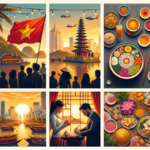When is the best time to visit Vietnam?
Vietnam is a captivating country that offers a rich tapestry of natural beauty, historic landmarks, and vibrant culture. This Southeast Asian gem is famous for its stunning landscapes, from the breathtaking limestone karsts of Ha Long Bay to the lush rice terraces of Sapa. Whether you’re traversing the bustling streets of Hanoi or exploring the ancient town of Hoi An, every corner of Vietnam promises an unforgettable experience. For those seeking adventure, Vietnam’s diverse geography supports activities like trekking, biking, and water sports, making it a perfect destination for nature lovers and thrill-seekers alike.
When planning your visit, it’s essential to know the best time to visit Vietnam for the ultimate experience. The country boasts a tropical climate, characterized by distinct wet and dry seasons, which significantly influence the weather conditions. Understanding the climatic patterns allows tourists to tailor their trips to coincide with favorable weather, ensuring memorable moments while exploring Vietnam’s cultural heritage and natural wonders.
Vietnam experiences three primary tourist seasons: Peak, Mid, and Valley.
- Peak Seasons: The busiest periods occur during the dry seasons, particularly from December to February and June to August, when many international tourists flock to the country for holidays and summer vacations. The pleasant weather during these months attracts numerous travelers.
- Mid Seasons: The transitional months of March to May and September to November offer a good balance with fewer crowds and moderate weather, making it an ideal time for those looking for a more relaxed experience without sacrificing the beauty of the landscapes.
- Valley Seasons: The months of May and October, which experience a higher chance of rain and humidity, are considered off-peak. While fewer tourists visit during this time, it can still be a unique opportunity to witness the lush green landscapes and experience Vietnam’s culture more intimately.
The weather in Vietnam varies significantly from north to south. In the north, average temperatures range from 15°C in winter to about 30°C in summer, while the south experiences a more consistent climate with temperatures averaging between 25°C and 35°C. Rainfall is abundant in the central regions during the rainy season, particularly from September to December, with average monthly precipitation reaching up to 300mm.
Vietnam is rich in cultural festivities and events that can enhance your travel experience. Some notable festivals include:
- Tet Nguyen Dan: The Vietnamese New Year, celebrated in January or February, is the most significant holiday, marked by family reunions and traditional rituals.
- Mid-Autumn Festival: This festival in September or October features vibrant lantern parades and mooncake sharing, celebrating the harvest and family togetherness.
- Hue Festival: A celebration of culture and arts held every two years in April, showcasing traditional music, dance, and culinary delights.
- Hanoi International Film Festival: This October event attracts filmmakers from around the world, enriching the cultural scene in the capital.
- Da Nang International Fireworks Festival: An annual event that takes place in June, featuring extravagant firework displays from various countries.
In conclusion, discovering the best time to travel to Vietnam can lead to a truly transformative experience. With its vibrant culture, stunning landscapes, and rich traditions, you will find that every season offers unique opportunities to explore the heart and soul of this enchanting country.


